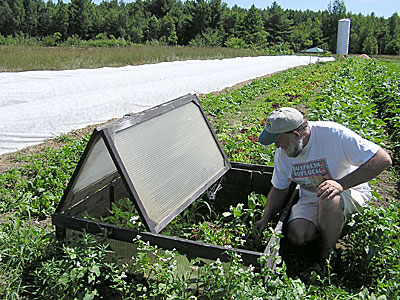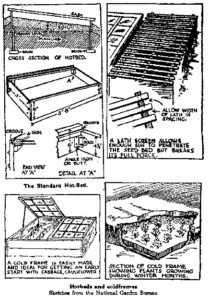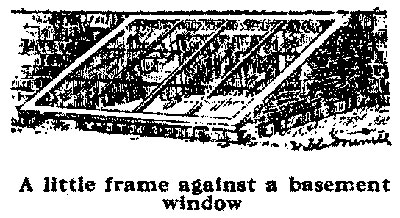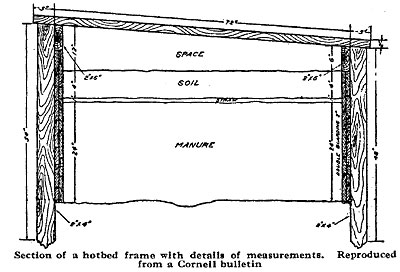 |
| At the Small Farm Field Day in Unity, Russ Libby demonstrated growing crops in a cold frame that has a folding top. English photo. |
By Jean English
Russ Libby, MOFGA’s executive director, has been growing garden crops in cold frames – “one of my favorite tools” – for about 18 years. His first frames consisted of storm windows atop boards, he told several Small Farm Field Day participants at MOFGA’s Common Ground Education Center in Unity in July. “I’ve gotten more serious over time.”
Cold frames give growers a jump on spring planting and a longer harvest in the fall. They give about 12 degrees F. of crop protection, so hardy crops can be grown when the temperature outdoors drops as low as 20 degrees F. In the spring, they provide a place to start seedlings. Even in summer, crops can be grown in open frames, where they’re protected from wind and grow faster than unprotected crops. You could start growing pickling cucumbers in frames in late July and have the produce ready in the fall, Libby suggested.
Libby makes his frames using 1 x 8 eastern white cedar for the front boards, 1 x 12 for the back, and sides sloping accordingly. “Try to make the frames match [the dimensions] of the beds in your garden,” he recommends. Frames that are short in depth but long in length will be easier to reach into from front and back. Libby noted that frames help break up garden work into more discrete jobs.
One of Libby’s homemade frames lasted through 14 winters and was just starting to pull apart at the joints. Libby planned to make his new beds 9 feet wide and 61/2 feet deep. “I’ll have to climb into them” to tend them, he said. [Growers can put narrow boards on top of the soil inside cold frames; stepping on the boards rather than directly on the soil will distribute their weight and impact the soil less.]
The 3- x 6 1/2-foot sliding glass porch doors that he now uses as sashes are heavy, but were free. (Lexan and other substitutes, including polyethylene plastic, are available, but usually have to be purchased. Glass has the drawback that it may break in the garden.) The covers slide into grooves in separate frames made of eastern white cedar. Libby suggests that growers figure out the weight of sashes they can lift and the depth of beds they can reach when planning their frames.
 |
| National Garden Bureau designs for cold frames and hot beds. From 1001 Garden Questions Answered, by Alfred C. Hottes, A.T. De La Mare Co., Inc., N.Y., 1939. |
Planting
“Now is the time to plant things that will go to Thanksgiving and maybe Christmas,” Libby noted at the late July event. He suggested sowing spinach, kale and lettuce. Later sowings will reap later harvests, and other crops to consider are hardy Chinese greens, corn salad (which can be seeded until mid-November), and mache (which will last all winter). “Last year I started lettuce from seed in mid-October and harvested it in April,” said Libby.
“Cold frames are basically outdoor refrigerators. If you get the crop big enough, you can store it” into or through the winter in the frames. He added that Eliot Coleman’s book “is right on for dates of seeding.” (The Winter-Harvest Manual, farming the back side of the calendar; 2001; $15 payable to Four Season Farm; from Four Season Farm, 609 Weir Cove Rd., Harborside, ME 04642; www.fourseasonfarm.com) During the winter, Libby removes snow from the frames with a broom or shovel when it’s more than 6 inches deep.
Greens and radishes can also be seeded in frames in February for harvest in mid- to late March, after which another crop of greens can be sown. Then the frames can be moved onto melon and cucumber plants to give those heat-lovers a boost.
Commercial Potential
Cold frames were the standard way to produce crops 100 years ago, Libby said, citing one farm outside of Providence, Rhode Island, that had 1,000 frames, each 64-square-feet in size. “It’s striking how many frames people used to put out; 500 was just a starter. In the 1880s, one-quarter of Paris was under cultivation” using frames.
In the late 1880s, 9 inches of manure was commonly placed under 6 inches of soil in cold frames to create “hot beds” as the manure composted and released heat. These frames were commonly long rows of boards with sashes and without cross pieces, rather than frames broken up into shorter lengths; thus growers could plow inside the beds, bring in manure and soil, and grow crops all winter. This system domin ated until about 1920, when other heating systems became available and were used in greenhouses.
Today, Libby sees cold frames as a way for new growers to save a little money, make a little money, and eventually get to the point where they can buy a hoop house. “Having 50 heads of lettuce for the early market is a really nice thing.” (Frames full of lettuce were also nice for his daughter, who organized a month-long CSA of cold frame-grown lettuce when she was in high school to pay for her trip to Washington, D.C.)
 |
| A cold frame against a basement window can gain some protection from cold from the building. |
 |
| One way to create a hot bed using the heat generated from horse manure. |
Growers can overwinter perennials in cold frames, if they wait until the ground has frozen in order to deter moles and voles; and they can grow earlier-blooming pansies and violets in frames. In late July, Libby had just started pansies in soil blocks and planned to transplant them to frames later.
Frames are labor-intensive, as they need to be vented. Blocks of 2 x 4 wood can be placed under the glass to hold it up as soon as the sun comes out (standing the block the narrow or wide way, depending on the day). “Err on the side of opening” the cold frame if you’re not going to be home for the day, he advised.
When asked about using hay bales as sides for a cold frame, Libby said that could be done, but hay tends to attract mice in the winter.

